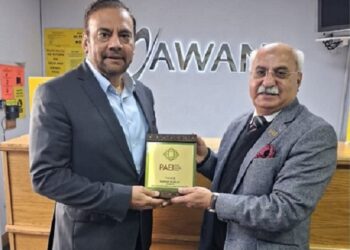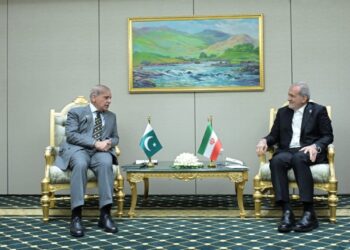Pakistan unveils a plan to cut costs, expand markets, and boost textile exports, aiming to enhance industry growth and global competitiveness.
Pakistan’s strategy to reduce costs and boost exports:
Pakistan’s Ministry of Commerce has introduced a comprehensive plan to increase the export of value-added textile goods. The strategy aims to reduce production costs, improve economies of scale, and conduct focused marketing events. By implementing these measures, the government hopes to strengthen the textile sector, enhance economic growth, and compete better in international markets.
This initiative is crucial, as the textile industry plays a significant role in Pakistan’s economy. It contributes heavily to employment, industrial production, and exports. By addressing key challenges and adopting modern techniques, the government aims to revitalize the sector and maximize its potential.
Features of the Export Growth Plan:
The new plan is designed to overcome barriers in the textile industry and enhance its competitiveness. Below are the main aspects of this strategy:
Reducing Production Costs:
One of the major hurdles for Pakistan’s textile sector is the high cost of production. The plan focuses on:
- Lowering energy costs by using renewable energy sources.
- Introducing cost-effective raw materials and local input materials.
- Encouraging automation and modern technology to increase efficiency.
By reducing production costs, textile manufacturers can offer competitive prices in the global market.
Expanding to New Markets:
To reduce dependence on traditional markets like the US and Europe, Pakistan aims to explore non-traditional markets such as:
- African countries
- South America
- Central Asia
By expanding to new markets, Pakistan’s textile sector can increase exports and attract more buyers.
Focusing on High-Value Products:
Instead of exporting raw materials and low-value textiles, the plan encourages the production of:
- Technical textiles (used in healthcare, defence, and automotive industries).
- High-quality apparel and fashion wear.
- Sustainable and eco-friendly textile products.
This approach will help Pakistan earn more revenue and compete with leading textile-exporting nations.
Simplifying Trade Barriers:
Non-tariff and technical trade barriers often slow down exports. The government plans to:
- Simplify export regulations and documentation.
- Improve coordination with international trade organizations.
- Negotiate better trade agreements with key markets.
These measures will help businesses export their products more smoothly and efficiently.
Encouraging Research and Development (R&D):
Innovation is key to long-term success. The government plans to:
- Invest in R&D projects for high-tech textile production.
- Collaborate with universities and research institutions.
- Support businesses in adopting modern techniques.
By focusing on R&D, the industry can develop advanced fabrics and remain competitive.
Challenges Facing Pakistan’s Textile Industry:
While the new plan is promising, Pakistan’s textile industry faces several challenges that must be addressed:
Decline in Cotton Production:
Pakistan was once the third-largest cotton producer in the world, but it has now fallen to sixth place. The key reasons include:
- Low-quality seeds and outdated farming methods.
- Pest attacks and climate change effects.
- Lack of investment in modern agricultural technology.
Energy Crisis and High Costs:
Electricity and gas shortages have increased the cost of textile production. Many textile mills struggle with power outages and expensive energy rates. The government is looking at renewable energy solutions to address this issue.
Global Competition:
Countries like Bangladesh, India, and Vietnam have strong textile industries. They offer lower production costs, better infrastructure, and strong government support. Pakistan needs to improve its competitiveness through better policies and efficient production.
Limited Access to Finance:
Small and medium-sized textile businesses often face difficulties in getting loans and financial support. The government aims to introduce programs that help these businesses expand and modernize.
Government’s Strategy to Overcome Challenges:
To address these issues, the government has outlined several strategies:
Reviving Cotton Production:
To boost the local cotton supply, the government plans to
- Introduce climate-resistant and disease-resistant cotton seed varieties.
- Prohibit uncertified seeds and harmful chemicals.
- Promote mechanized harvesting and modern farming techniques.
Improving Infrastructure and Energy Supply:
- Investing in renewable energy sources such as solar and wind power.
- Developing textile industrial zones with stable power supplies.
- Reducing electricity and gas tariffs for textile exporters.
Strengthening International Trade Relations:
- Negotiating better trade agreements with major textile-importing countries.
- Reducing import duties on essential raw materials.
- Strengthening ties with organizations like the WTO to improve trade policies.
Supporting Small and Medium Enterprises:
The government recognizes that SMEs are vital to the textile sector. To support them, it plans to:
- Offer low-interest loans for machinery upgrades.
- Provide training programs to improve skills and efficiency.
- Develop a national action plan to integrate SMEs into the mainstream textile industry.
Current Growth:
Despite challenges, Pakistan’s textile and apparel industry has shown resilience. In the first eight months of the 2024–25 fiscal year, textile exports grew by 9.3% compared to the previous year. Additionally, apparel exports saw a 19% increase, reaching an all-time high of $6.2 billion.
Commerce Minister Jam Kamal emphasized that the government is committed to increasing exports of value-added products. By utilizing locally produced materials and implementing supportive policies, Pakistan aims to further boost its textile exports.
Why This Plan is Crucial for Pakistan’s Economy:
The textile sector is one of Pakistan’s largest industries, contributing significantly to employment and GDP. Increasing textile exports will:
- Create more jobs, especially for women in rural areas.
- Improve Pakistan’s trade balance by reducing reliance on imports.
- Strengthen the overall economy by attracting foreign investment.
By implementing this plan, Pakistan has the potential to regain its position as a leading textile-exporting nation.
Conclusion:
The Ministry of Commerce’s new plan provides a roadmap for Pakistan’s textile industry to cut costs and boost exports. Through strategic interventions such as reducing production costs, expanding into new markets, improving research and development, and reviving local cotton production, the government aims to enhance the sector’s global competitiveness.
While challenges remain, the commitment to innovation, trade expansion, and infrastructure improvement offers hope for long-term success. With strong policies and industry cooperation, Pakistan’s textile industry can achieve significant growth and make a lasting impact on the country’s economic development.

























